#Kamloops Lake
Explore tagged Tumblr posts
Text
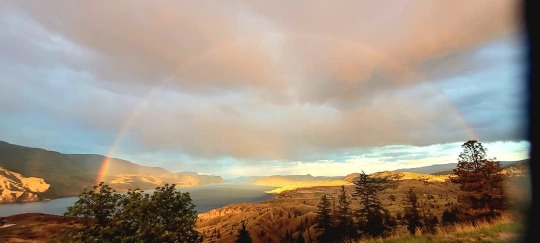
facebook.com
Stephen Sam MacAulay
16 notes
·
View notes
Text
















Apple Tree Day
Apple Tree Day could also be called ‘Put a Doctor Out of Business Day’ simply because of the health benefits contained in this delightful fruit! However, the origin of this day is quite different. Apple Tree Day started as a celebration of an old apple tree almost two centuries old, and has grown to become a celebration of the apple itself.
History of Apple Tree Day
The apple tree is a deciduous tree that, somewhat surprisingly, hails from the same family as the rose. Its ancestor is the Malus sieversii, a tree that is still grown to this day. Originating in Central Asia, apples then made their way to Europe where they grew for many years before European colonists brought them over to North America during the 17th century. It is possible that apple trees are the oldest tree to have been cultivated.
When considering the long journey that apples have gone on around the world and the fact that they are still one of the most popular foods of today, it is not hard to see why they deserve to be celebrated!
Apple Tree Day started off as a celebration of an old apple tree, which had been around for two centuries. As time went on, this day morphed into a celebration of the fruit itself.
How to Celebrate Apple Tree Day
Celebrating Apple Tree Day is easy with these ideas to get started:
Join in on an Apple Tree Day Event
It is a good idea to take a look online and see whether there are any events that are going on in your local area. A lot of communities may host local village festivals on Apple Tree Day, selling the most delicious homemade apple treats. This might include everything from apple pies to apple cider. It’s a great way to be a part of the community and enjoy some of the local produce.
Even for people who don’t have access to an organized function on Apple Tree Day, it’s still possible to participate – just eat an apple, drink apple cider or eat meals with apple in them.
Read an Apple Themed Book
Whether there are children around–or just children at heart–take a look at some of these delightful books themed around the idea of apples and apple trees:
The Apple Pie Tree by Zoe Hall (1996) This delightful book follows the two sisters and they discover the various seasons and progressions an apple tree goes through before it renders fruit fit for making pies.
Apples, Apples, Apples by Nancy Elizabeth Wallace (2004) This children’s book tells the story of a family of bunnies who visit the apple orchard. The book also includes a recipe for applesauce.
Who Was Johnny Appleseed? by Joan Holub (2005) This biography tells the legendary story of John Chapman, who was responsible for bringing apples to the midwestern United States.
How Do Apples Grow? by Betsy Maestro (1993) An introduction to environmental science, this children’s book addresses kids’ questions and informs them on facts about apple trees and their fruit.
Plant an Apple Tree
Traditionalists might want to take apple tree cuttings and plant them, but for those who don’t have a green thumb it’s just as acceptable to plant an apple tree bought from a plant nursery. For those who live in regions where January isn’t quite the right season for tree planting, get a head start on taking care of that apple tree by signing up for a course on fruit tree pruning.
Pick Apples and Bake with Them
Depending on the particular location, some people might be able to spend Apple Tree Day picking some fresh apples and using them to bake an incredible creation. There are so many different desserts that call for the use of apples. This includes traditional desserts, such as Apple Cake, Apple Crumble, and Apple Pie.
There are also modern recipes that can be found online and in cookbooks today. Examples of these delicious treats might include Apple Crumb Cheesecake Pie, Salted Caramel Apple Crisp, Apple Cider Cupcakes with Cinnamon Buttercream, and much more. All that is needed is to do a quick search online and anyone is bound to come across plenty of delicious apple-based treats!
Don’t forget, when peeling those apples, to hold a competition to see who can peel an apple to make the longest ‘Slinky’ – people don’t even have to eat the apples to be involved in the process!
Try Making Apple Cider
You could even try your hand at making your own apple cider. You have two options here. You can go down the easy route of purchasing one of the apple cider making kits that are available in stores. The other option is to make your own apple cider from scratch. This does require quite a lot of hard work, but it will all be worth it in the end!
Participate in Apple-Based Traditions
And since this day comes just once a year, those who are in love can declare it by throwing a Golden Delicious at the ‘apple of your eye’ and see if they reciprocate those affections by catching it. If they don’t, there’s always next year!
Learn About the Benefits of Eating Apples
On this day, everyone is encouraged to learn more about apples and the importance of including them into their diet. In fact, there are a lot of benefits that are associated with eating apples! Perhaps this has something to do with the old adage declaring that “an apple a day keeps the doctor away”.
Apples contain a variety of different antioxidants, including chlorogenic acid, phloridzin, catechin, and quercetin. There have been a number of different studies into the links between eating apples and lowering your cholesterol, reducing the risk of certain diseases and helping with managing weight.
Learn About Different Types of Apples
One way to pay honor to the Apple Tree on this day is by delving deeper into the different types of apples that are available (there are more than 7500 different varieties worldwide!), understanding the unique benefits they provide and the unique taste experience they have to offer. Here are some interesting apple varieties to get started with:
Gala Apples Currently the most popular apple variety in the United States, Gala apples are mildly flavored, sweet, and juicy. These apples are great for just eating whole or baking into a delicious treat.
Red Delicious This classic apple is what many people think of when it comes to taking an apple for the teacher’s desk! These were the most popular in the US for many years, but have fallen to second in deference to something a bit crunchier and sweeter.
Granny Smith This green apple is native to Australia and has a super tart flavor that makes it perfect for baking with.
Fuji Apples This variety was named for Mt. Fuji in Japan in the 1930s, but is now super popular with Americans as it has been around since the 1980s. Its yellow and red color gives it a distinctive look and it’s delightfully sweet, juicy flavor is great for eating.
Source
#Damariscotta Shell Midden Historic District#Maine#Beringer Vineyards#USA#Cape Neddick Point#Palo Duro Canyon State Park#Texas#original photography#St. Helena#Napa Valley#Kamloops Lake#travel#British Columbia#Canada#California#summer 2022#2018#2012#vacation#flora#landscape#tourist attraction#landmark#fruit#Apple Tree Day#6 January#AppleTreeDay#2023
1 note
·
View note
Text


Kamloops Lake, B.C.
0 notes
Text


Red Lake, Kamloops BC
7 notes
·
View notes
Text
Lake Superior’s Greatest Mystery: SS Kamloops
youtube
9 notes
·
View notes
Text

0 notes
Text
A First Nation in B.C.'s Interior has received more than $147 million from the federal government after more than 20 years of fighting for the acknowledgement of its water rights. The Esk'etemc (pronounced es-KET-em) First Nation, located southwest of Williams Lake, B.C., first filed with Specific Claims, which deals with past wrongs against First Nations in Canada, in 2003, raising issues arising from being prevented from completing an irrigation ditch in the 1890s. In 1881, land was set aside for Wycott's Flat Indian Reserve #6 and the agreement noted that all the water flowing out of a nearby lake was reserved for the Esk'etemc Nation, according to Anispiragas Piragasanathar, a spokesperson for Crown-Indigenous Relations and Northern Affairs Canada. The Esk'etemc Nation said all the water from Vert Lake, southeast of the reserve, was promised to the Esk'etemc for irrigation as part of a reserve land agreement. The First Nation started digging in the 1890s, but after two years of work and just one kilometre away from completion, it was told it had to stop. "It was devastating," lawyer Stan Ashcroft told CBC's Daybreak Kamloops guest host Doug Herbert. "I mean, after all that effort to be told you can't continue, when I talked to the elders, they said it was completely devastating." The irrigation ditch has lain dormant since, according to the First Nation.
Continue Reading
Tagging: @newsfromstolenland
119 notes
·
View notes
Text


Messages, some dating back a century, written by children on the walls of a barn on the site of the former St. Joseph’s Mission Indian residential school.
Rick Gilbert, a survivor of St. Joseph’s Mission, tends to the Catholic cemetery on the grounds of the school.
During the 19th and 20th centuries, government programs in both the United States and Canada forcibly separated Indigenous children from their families, relocating them to residential boarding schools to “civilize” them. The Truth and Reconciliation Commission of Canada has acknowledged this as a form of cultural genocide.
In 2021, this awful history got a fresh round of public discourse when surveying work on the grounds of the Kamloops residential school in British Columbia identified around 200 unmarked graves. (Officially, 51 children are currently recognized as having died at the school.)
These events spurred Julian Brave NoiseCat and Emily Kassie to collaborate on Sugarcane (2024), a documentary about Canada’s residential school system. It’s told from the perspective of now-elderly survivors of St. Joseph’s Mission, another such school in British Columbia, including Julian’s father, Ed. (The documentary gets its name from the nearby Williams Lake Indian Reserve, which is often called “Sugarcane.”)
[ x ]
#chromatic voice#sugarcane 2024#julian brave noisecat#emily kassie#residential schools#truth and reconciliation#turtle island#canadian content#settler colonialism
50 notes
·
View notes
Text
THIS DAY IN GAY HISTORY
based on: The White Crane Institute's 'Gay Wisdom', Gay Birthdays, Gay For Today, Famous GLBT, glbt-Gay Encylopedia, Today in Gay History, Wikipedia, and more … December 27



c.15 AD – John the Evangelist. The Gospel of John makes several references to "the disciple Jesus loved", and to "the Beloved Disciple", including references to special priviliges that Jesus gave to this relationship, not granted to other disciples. This is taken by some Biblical scholars as evidence that Jesus had a relationship with this disciple which was at least emotionally intimate, and possibly sexual. In medieval Northern Europe, there was even a long-standing tradition that he and Christ were the bridal couple at the Cana Wedding Feast.
It is not clear whether this "Beloved Disciple" was John himself (although it could have been), or someone else possibly Lazarus.
In any event, there are suggestions from elsewhere that John may have had a same-sex relationship with another, his scribe Prochorus, after Christ's death. Prochorus later became bishop of Nicomedia, and in turn, formed a fresh relationship of his own with a younger man, Irenaeus.


1846 – Ezra Allen Miner, more popularly known as Bill Miner, was an American bandit, originally from Bowling Green, Kentucky, who served several prison terms for stagecoach robbery (d.1913). Known for his unusual politeness while committing robberies, he was widely nicknamed the Grey Fox, Gentleman Robber or the Gentleman Bandit. He is reputed to have been the originator of the phrase
"Hands up!"
Legend has it that Bill Miner admonished his cohorts to fire their guns when in danger of capture but "do not kill a man".
Miner was born Ezra Allen Miner in Vevay Township, near Onondaga, Ingham County, Michigan. He never legally changed his first name, but regarded William Allen Miner as his true name throughout most of his life. He was arrested for the first time in 1866 in San Joaquin County, California and served time there. He then formed a partnership with Bill Leroy to rob a stagecoach. Leroy was caught and lynched, but Miner escaped. He was later caught for another robbery in Tuolumne County, California and was released from San Quentin in 1901.
After his third prison term, Miner moved to British Columbia in Canada, where he adopted the pseudonym George Edwards and is believed to have staged British Columbia's first-ever train robbery on September 10, 1904 at Silverdale about 35 kilometres (22 mi) east of Vancouver, just west of Mission City.
Miner was eventually caught after a botched payroll train robbery near Kamloops at Monte Creek (then known as "Ducks"). Choosing the wrong car, they managed only to rob $15 plus a bottle of kidney pills that Miner picked up off of a shelf. Miner and his two accomplices, Tom "Shorty" Dunn and Louis Colquhoun, were located near Douglas Lake, British Columbia after an extensive manhunt. A posse surrounded them while they were lunching in the woods. Miner presented himself as George Edwards and claimed that he and his cohorts were prospectors. The officer in charge of the posse suspected he had encountered the nefarious train-robbing gang and challenged the claim, putting them under arrest.
Dunn attempted to fire at the police and was shot in the leg. He gave up quickly after being wounded. Colquhoun was disarmed by an officer standing nearby and Miner never drew his weapon. Miner's arrest and subsequent trial in Kamloops caused a media spectacle. Apparently the most damning evidence against him was the bottle of kidney pills that Miner had picked up during the Ducks robbery. Upon his conviction, he, Dunn and Colquhoun were transported by train to the provincial penitentiary in New Westminster. By that time, Miner's celebrity status had risen to the point that the tracks were reputedly lined with throngs of supporters, many of whom expressed satisfaction with the fact that someone had taken the very unpopular CPR to task.
While serving time in the B.C. Penitentiary, Miner escaped in 1907 and was never recaptured in Canada. He moved back to the United States, becoming once again involved in robberies in the South at Gainesville in 1909. There, he served more prison time, and escaped twice.
He died in the prison farm at Milledgeville, Georgia, of gastritis, contracted from drinking brackish water during his previous escape attempt.Researchers Mark Dugan and and John Boessenecker contend that Miner was the only known homosexual outlaw in the American "Wild West." In his younger days, "Miner, who had a slender, girlish figure, no doubt was a target for sex-starved older and stronger convicts." Later, they claim, he lured young men into crime and preyed on them sexually. Whatever Miner's sexual preference, the only evidence of Miner's homosexuality surfaced in 1903 when the Pinkerton Detective Agency stated that Miner "is said to be a sodomist and may have a boy with him."


1901 – Marlene Dietrich (d.1992) was a German-American actress and singer.
Dietrich remained popular throughout her long career by continually re-inventing herself, professionally and characteristically. In the Berlin of the 1920s, she acted on the stage and in silent films. Her performance as Lola-Lola in The Blue Angel, directed by Josef von Sternberg, brought her international fame and provided her a contract with Paramount Pictures in the US.
Hollywood films such as Shanghai Express and Desire capitalised on her glamour and exotic looks, cementing her stardom and making her one of the highest paid actresses of the era. Dietrich became a US citizen in 1937, and throughout World War II she was a high-profile frontline entertainer.
Although she still made occasional films in the post-war years, Dietrich spent most of the 1950s to the 1970s touring the world as a successful show performer.
Unlike her professional celebrity, which was carefully crafted and maintained, Dietrich's personal life was kept out of public view. Dietrich, who was bisexual, enjoyed the thriving gay scene of the time and drag balls of 1920s Berlin.
She married only once, to assistant director Rudolf Sieber, who later became an assistant director at Paramount Pictures in France, responsible for foreign language dubbing.
Throughout her career Dietrich had an unending string of affairs, some short-lived, some lasting decades; they often overlapped and were almost all known to her husband, to whom she was in the habit of passing the love letters of her men, sometimes with biting comments.
During the filming of Destry Rides Again, Dietrich started a love affair with co-star Jimmy Stewart, which ended after filming. In 1938, Dietrich met and began a relationship with the writer Erich Maria Remarque, and in 1941, the French actor and military hero Jean Gabin. Their relationship ended in the mid-1940s. She also had an affair with the Cuban-American writer Mercedes de Acosta, who was Greta Garbo's lover. Her last great passion, when she was in her 50s, appears to have been for the actor Yul Brynner, but her love life continued well into her 70s. She counted John Wayne, George Bernard Shaw and John F. Kennedy among her conquests. Dietrich maintained her husband and his mistress first in Europe and later on a ranch in the San Fernando Valley, California.
In 1999, the American Film Institute named Dietrich the ninth greatest female star of all time.


1932 – On this date Fritz "Fred" Klein the Austrian-born American sex researcher, psychiatrist and pioneering Bisexual rights activist was born (d.2006). He's best known as the inventor of the Klein Sexual Orientation Grid. He was also a pioneering bisexual rights activist, who was an important figure in the modern LGBT rights movement.
As a self-identified bisexual, Klein was surprised at the lack of literature on his sexuality in the New York Public Library in 1974. He was inspired to place an advertisement in a New York City alternative newspaper the Village Voice and founded a ground-breaking social and support group for the Bisexual Community called Bisexual Forum.
He devised the Klein Sexual Orientation Grid, a multi-dimensional system for describing complex sexual orientation, similar to the "zero-to-six" scale Kinsey scale used by Alfred Kinsey, but measuring seven different vectors of sexual orientation and identity (sexual attractions, sexual behavior, sexual fantasies, emotional preference, social preference, lifestyle and self-identification) separately, as they relate person's past, present and ideal future.
Klein published The Bisexual Option: A Concept of One Hundred Percent Intimacy in 1978, based on his research, the world's first real psychological study of bisexuality. He also co-authored Man, His Body, His Sex in 1978, and published Bisexualities: Theory and Research in 1986 and Bisexual and Gay Husbands: Their Stories, Their Words in 2001. He published a novel, Life, Sex and the Pursuit of Happiness in 2005.


1962 – Joseph Mantello is an American actor and director best known for his work on Broadway productions of Wicked, and Assassins, as well as earlier in his career being one of the original Broadway cast of Angels in America. Mantello directed The Ritz, his sixth production with playwright Terrence McNally, in 2007.
Joe Mantello was born the oldest son of an Italian-American family in the suburban community of Rockford, Illinois, a city some 90 miles outside of Chicago. With his parents' encouragement, he spent much of his childhood acting in community theater.
In 1984, he graduated from the North Carolina School of the Arts with a Bachelor of Fine Arts degree in acting. That same year he moved to New York to pursue a career in theater. As an actor, Mantello appeared in several Off Broadway productions.
Mantello's early acting career culminated in the original Broadway production of Tony Kushner's groundbreaking seven-hour, two-play cycle Angels in America (1993). In both of the play's two parts, Millennium Approaches and Perestroika, Mantello portrayed Louis Ironson, a liberal, self-centered Jewish New Yorker who leaves his lover Prior Walter, a gay man struggling with AIDS, and becomes involved with Joe Pitt, a Mormon Republican lawyer struggling with his sexuality.
Since his appearance in Angels in America, however, he has concentrated on his directing career. Nevertheless, in early 2011 Mantello returned to acting in a limited-run Broadway production of The Normal Heart, Larry Kramer's 1985 landmark play about the AIDS crisis.
Mantello also drew attention for his widely-chronicled romantic partnership from 1990 to 2002 with the playwright Jon Robin Baitz. In 1994, the New York Times dubbed the two men "the New York theater's couple of the moment."
They were linked professionally as well, with Mantello directing several of Baitz's plays. As the New York Times' Bruce Weber noted, their personalities and talents are "complementary," with Mantello's "warmth and humor burnishing" Baitz's "intellectual rigor and undercutting his earnestness."
When the two men separated after 12 years together, Mantello felt "completely isolated and heartbroken," but he never ascribed blame for the breakup to Baitz. "Neither of us felt wronged," Mantello later explained. "There wasn't another person. It was just a very painful, mutual acknowledgement that we had evolved from being a couple who lived together into best friends."
Indeed, Mantello and Baitz have remained friends, and in 2011 the two men reunited professionally, when Mantello directed, to critical acclaim, Baitz's new play Other Desert Cities.
Other noeworthy productions by Mantello include Terrence McNally's play Love! Valour! Compassion!, about eight gay men sharing a series of summer holidays in an upstate New York house; and Richard Greenberg's Take Me Out, which focuses on the issue of gay athletes in the straight-male-dominated world of professional sports.


1973 – Wilson Cruz (born Wilson Echevarría) is an American actor known for playing Rickie Vasquez on My So-Called Life and the recurring characters of Junito on Noah's Arcand Dr. Hugh Culber on Star Trek: Discovery. As an openly gay person of Puerto Rican ancestry, he has served as an advocate for gay youth, especially gay youth of color.
Wilson Cruz was born in Brooklyn, New York to parents of Puerto Rican descent. His family eventually moved to Rialto, California where he attended Eisenhower High School, graduating in 1991. At age 19, Cruz came out to his parents as gay, first to his mother and then his father. While his mother was initially hurt and shocked, she eventually accepted the news. His father, however, threw him out of the house, and Cruz spent the next few months living in his car and at the homes of friends. He later reconciled with his father.
After coming out to his parents, Cruz went to Hollywood to seek work as an actor, intending to be open about his sexuality from the beginning of his career. In 1994 he was cast as Enrique "Rickie" Vasquez, a troubled gay teen, in the short-lived critically acclaimed cult classic TV series My So-Called Life. In one episode (entitled "So-Called Angels") drawn from Cruz's own life, Rickie comes out to his family, who throw him out of the house.
Cruz works with and advocates on behalf of LGBT youth, especially youth of color. He has volunteered his time as host for the Youth Zone, an online community at Gay.com for LGBT youth. He was the Grand Marshal of the 1998 West Hollywood Gay Pride parade and the 2005 Chicago Pride Parade. In 2008, he was the keynote speaker at the University of Illinois at Chicago's Lavender Graduation and Rainbow Banquet honoring graduating LGBT students.
Cruz joined the board of directors of GLAAD in 1997 in order to assist the organization through a leadership transition, and joined the staff of GLAAD in 2012 as a National Spokesperson and Strategic Giving Officer.


Rowland in his army days
1990 – Died: Chuck Rowland (b.1917) was a founding member of the Mattachine Society. He was active with ONE Inc. and founded the short-lived Church of One Brotherhood. Upon retiring from twenty years of teaching in 1982, Rowland founded Celebration Theatre in Los Angeles.
Chuck Rowland was born and grew up in tiny Gary, South Dakota. He recognized he was homosexual at an early age, and after reading a sympathetic series of articles in a pulp magazine, concluded that, if millions like him existed, they could be mobilized. At the University of Minnesota in the late 1930s, he was active on campus in support of the loyalists of Spain and other causes. While in grad school during 1939–40 he returned to Gary as a substitute for the spring term. On a weekend visit to Minneapolis, he met Bob Hull, a U of M undergraduate. The two had a brief romance, lived together, and became lifelong friends.
In 1942, Rowland was drafted into the army. Due to a severe injury, he stayed stateside during the war. While enlisted, Rowland became a charter member of the American Veterans Committee, a liberal alternative to the American Legion. After discharge in March 1946, he showed his talent as an AVC organizer, but his active support for veterans’ bonus legislation, which the group disparaged as “handouts,” led to his being “canned” by the AVC by 1947.
While in the AVC, Rowland noted that those he knew to be communists were some of AVC’s best organizers. “I was just carried along with this feeling of liberalism and the horror of the [anti-communist] reaction that was setting in,” he said, “and my feeling was that we had to move farther and farther to the left, as a result of which I got into the Communist Party.” Rowland returned to Minneapolis and headed the CP’s Midwest youth division.* (His value as an organizer trumped any chance of being expelled under the party’s unwritten anti-gay policy.) Rowland recruited Hull into the party, and the two contemplated Rowland’s childhood dream of organizing homosexuals.
In 1948, he quit the CP and move to Los Angeles, followed by Hull. There, at a labor school, the two met a teacher, Harry Hay, who also had done some thinking about a homosexual organization.
Harry Hay was developing a blueprint for a homophile support group, but before he could show it to them, Rowland and Hull moved to Mexico in the summer of 1950, intending to relocate permanently to avoid anti-Communist witch-hunts. They returned by fall, however, and received Hay’s completed prospectus, which they eagerly shared with Hull’s new boyfriend, Dale Jennings. The three met with Hay and his lover Rudi Gernreich on Armistice Day 1950, and eventually formed the (necessarily) secretive Mattachine Society and its public nonprofit, Mattachine Foundation.

Mattachine members clockwise from top: Chuck Rowland, Konrad Stevens, unknown, Bob Hull, Jim Gruber
Rowland immersed himself in ONE Inc., writing for its magazine and directing its social services division. In 1954 he proposed that ONE open a guidance center staffed with gay counselors to mentor the waifs who found themselves alone in a new city. The project foundered, but Rowland nevertheless reported to ONE that in 1955 his division provided job placement and/or vocational counseling for nearly 100 people.
The early 60s saw Rowland involved in a possible FBI blacklisting (as both Red and gay), a failed business partnership, a dependence on intoxicants, mounting debt, and eviction. Finally, following the tragic suicide of his friend Bob Hull in May of 1962, Rowland returned to the Midwest. That summer he was hired as a credentialed high school teacher in Iowa. Obtaining his master’s degree in 1967, he chaired the theater arts department at a Minnesota college.
Upon retiring in 1982, Rowland returned to Los Angeles from his “exile,” as he put it, while admitting to “some worthy accomplishments” and meaningful relationships. In late 1982, with Jim Kepner and ex-Mattachino Martin Block, Rowland founded Celebration Theatre, billed as “the only theatre in Los Angeles dedicated exclusively to productions of gay and lesbian plays.” Kepner hosted its debut in the late spring of 1983, in his National Gay Archives.
Having been hospitalized in March 1090 with prostate cancer that proved to be terminal, Rowland “moved to Duluth where a former student fixed up a handsome apartment overlooking the lake,” according to a Kepner-penned obituary. “He spent five happy months among students and relatives….” Chuck Rowland died December 27, 1990.


15 notes
·
View notes
Text

Kamloops Lake BC this morning.
36 notes
·
View notes
Text
















Apple Tree Day
Apple Tree Day could also be called ‘Put a Doctor Out of Business Day’ simply because of the health benefits contained in this delightful fruit! However, the origin of this day is quite different. Apple Tree Day started as a celebration of an old apple tree almost two centuries old, and has grown to become a celebration of the apple itself.
History of Apple Tree Day
The apple tree is a deciduous tree that, somewhat surprisingly, hails from the same family as the rose. Its ancestor is the Malus sieversii, a tree that is still grown to this day. Originating in Central Asia, apples then made their way to Europe where they grew for many years before European colonists brought them over to North America during the 17th century. It is possible that apple trees are the oldest tree to have been cultivated.
When considering the long journey that apples have gone on around the world and the fact that they are still one of the most popular foods of today, it is not hard to see why they deserve to be celebrated!
Apple Tree Day started off as a celebration of an old apple tree, which had been around for two centuries. As time went on, this day morphed into a celebration of the fruit itself.
How to Celebrate Apple Tree Day
Celebrating Apple Tree Day is easy with these ideas to get started:
Join in on an Apple Tree Day Event
It is a good idea to take a look online and see whether there are any events that are going on in your local area. A lot of communities may host local village festivals on Apple Tree Day, selling the most delicious homemade apple treats. This might include everything from apple pies to apple cider. It’s a great way to be a part of the community and enjoy some of the local produce.
Even for people who don’t have access to an organized function on Apple Tree Day, it’s still possible to participate – just eat an apple, drink apple cider or eat meals with apple in them.
Read an Apple Themed Book
Whether there are children around–or just children at heart–take a look at some of these delightful books themed around the idea of apples and apple trees:
The Apple Pie Tree by Zoe Hall (1996) This delightful book follows the two sisters and they discover the various seasons and progressions an apple tree goes through before it renders fruit fit for making pies.
Apples, Apples, Apples by Nancy Elizabeth Wallace (2004) This children’s book tells the story of a family of bunnies who visit the apple orchard. The book also includes a recipe for applesauce.
Who Was Johnny Appleseed? by Joan Holub (2005) This biography tells the legendary story of John Chapman, who was responsible for bringing apples to the midwestern United States.
How Do Apples Grow? by Betsy Maestro (1993) An introduction to environmental science, this children’s book addresses kids’ questions and informs them on facts about apple trees and their fruit.
Plant an Apple Tree
Traditionalists might want to take apple tree cuttings and plant them, but for those who don’t have a green thumb it’s just as acceptable to plant an apple tree bought from a plant nursery. For those who live in regions where January isn’t quite the right season for tree planting, get a head start on taking care of that apple tree by signing up for a course on fruit tree pruning.
Pick Apples and Bake with Them
Depending on the particular location, some people might be able to spend Apple Tree Day picking some fresh apples and using them to bake an incredible creation. There are so many different desserts that call for the use of apples. This includes traditional desserts, such as Apple Cake, Apple Crumble, and Apple Pie.
There are also modern recipes that can be found online and in cookbooks today. Examples of these delicious treats might include Apple Crumb Cheesecake Pie, Salted Caramel Apple Crisp, Apple Cider Cupcakes with Cinnamon Buttercream, and much more. All that is needed is to do a quick search online and anyone is bound to come across plenty of delicious apple-based treats!
Don’t forget, when peeling those apples, to hold a competition to see who can peel an apple to make the longest ‘Slinky’ – people don’t even have to eat the apples to be involved in the process!
Try Making Apple Cider
You could even try your hand at making your own apple cider. You have two options here. You can go down the easy route of purchasing one of the apple cider making kits that are available in stores. The other option is to make your own apple cider from scratch. This does require quite a lot of hard work, but it will all be worth it in the end!
Participate in Apple-Based Traditions
And since this day comes just once a year, those who are in love can declare it by throwing a Golden Delicious at the ‘apple of your eye’ and see if they reciprocate those affections by catching it. If they don’t, there’s always next year!
Learn About the Benefits of Eating Apples
On this day, everyone is encouraged to learn more about apples and the importance of including them into their diet. In fact, there are a lot of benefits that are associated with eating apples! Perhaps this has something to do with the old adage declaring that “an apple a day keeps the doctor away”.
Apples contain a variety of different antioxidants, including chlorogenic acid, phloridzin, catechin, and quercetin. There have been a number of different studies into the links between eating apples and lowering your cholesterol, reducing the risk of certain diseases and helping with managing weight.
Learn About Different Types of Apples
One way to pay honor to the Apple Tree on this day is by delving deeper into the different types of apples that are available (there are more than 7500 different varieties worldwide!), understanding the unique benefits they provide and the unique taste experience they have to offer. Here are some interesting apple varieties to get started with:
Gala Apples Currently the most popular apple variety in the United States, Gala apples are mildly flavored, sweet, and juicy. These apples are great for just eating whole or baking into a delicious treat.
Red Delicious This classic apple is what many people think of when it comes to taking an apple for the teacher’s desk! These were the most popular in the US for many years, but have fallen to second in deference to something a bit crunchier and sweeter.
Granny Smith This green apple is native to Australia and has a super tart flavor that makes it perfect for baking with.
Fuji Apples This variety was named for Mt. Fuji in Japan in the 1930s, but is now super popular with Americans as it has been around since the 1980s. Its yellow and red color gives it a distinctive look and it’s delightfully sweet, juicy flavor is great for eating.
Source
#Damariscotta Shell Midden Historic District#Maine#Beringer Vineyards#USA#Cape Neddick Point#Palo Duro Canyon State Park#Texas#original photography#St. Helena#Napa Valley#Kamloops Lake#BC#travel#British Columbia#Canada#California#summer 2022#2018#2012#vacation#flora#landscape#tourist attraction#landmark#fruit#Apple Tree Day#6 January#AppleTreeDay#2023
1 note
·
View note
Text
Mild gripe of course but I feel like many fic writers are unaware that major junior teams will only play teams from other leagues during the Mem Cup finals. Your Mississauga Steelhead or Kingston Frontenac is not going to see the Blazers on a regular basis. Do you know how far Lake Ontario is from Kamloops
31 notes
·
View notes
Text

Valerie Walsh
The Sentinel, watching over the herd. Above Kamloops Lake, B.C. Rocky Mountain Big-horned Sheep. July 27, 2024.
14 notes
·
View notes
Text
anyway i got a book on ghost ships on the great lakes from the library and i started it the other day and i completely missed that it was published in 1968 which puts it at such a weird time in great lakes shipping history. the most famous wreck wouldnt happen for another 7 years (the edmund fitzgerald sank in 1975 and was the last major wreck on the lakes) and was in the middle of a decade of huge losses for freighters on the lakes (the carl d bradley, the daniel j morrell, and the cedarville all sank within 10 years of each other with significant losses. only two and one survivors respectively from the first two ships). and one of the chapters is on the ss kamloops which would actually be found less than 10 years later in 1977 making it no longer a ghost ship. idk just fascinating. i'm excited to read more of it
#shay speaks#i watch too many videos on shipwrecks on youtube so i know a few of these already too#the first chapter is on the kaliyuga too which had one crew member who accidentally missed the launch#and that saved his life
4 notes
·
View notes
Note
happy dadfucker friday! as a fellow canadian, if you had to set a d/j story in canada, where would it be?
AAAAAAAAAAAAH IN MOTHAFUCKIN TRANQUILLE
I mean more properly in Kamloops but they'd be there in order to break into Tranquille. My friends and I once drove out there onto the lands and it was creepy as shit and we didn't break in because we were in our thirties and didn't want criminal records lol but--
john and dean would go there and they'd be cranky because john sold it to the boys as a trip, a family vacation, hey there's this weird place we'll drive past that's a buncha polka-dot lakes, bet that'll be cool. but the spotted lake, you can't really go down into and it's underwhelming, and they're tired of feeding off boxes of timbits, and sam is scrunched down in the backseat with his arms folded loudly declaring periodically that this isn't a vacation it's just MORE DRIVING and it's BORING, and john takes them onto a service road that seems to go on forever.
until he pulls up and shuts the car off and says, sam, go to sleep. your brother and me are gonna be back in three hours. if we take longer than that, get the mossberg and the blessed rosary and come to the solarium. dean's heart leaps in excitement and sam finishes drinking the last clearly canadian and grumbles and burrows under the jacket dad throws over him.
it's an abandoned asylum like any other but john talks about his theories out loud and dean nods with a thoughtful frown at each one. he even manages to make an observation about the ectoplasm behind some of the rotted peeling paint on the wall and dad scuffs his hair. the ghost turns out to be a boy who was sent to the nuthouse by his father as a convenient way to avoid the mounting suspicions that the father was molesting the boy. dean feels sorry for him but also disdainful. they get back to the car with eighteen minutes to spare, and sam wakes up long enough to say, i thought you forgot me.
let's find some breakfast, john says as he starts up the car and eases it out in reverse, arm slung across the passenger seat with his fingers brushing the ends of dean's hair. blueberry pancakes, whaddyou boys think?
sam's already asleep again now that he knows he's not needed. dean reaches for the timmy's cup with two inches left of a cold double double and feels very grown-up as he says, we could keep driving a while longer.
#asktransaction#this was so unnecessary to write but anyhow#thank you for this question lana. beauty eh#johndean#dadfucker friday
13 notes
·
View notes
Text
Day 11 - Rocky Mountaineer part 1
I'm behind again! Mostly because I've been busy experiencing stuff, and not connected to tech!!
Anyway, Day 10 started pretty early - coach pick up at the hotel was 7:50am, but our luggage had to be outside our rooms for collection an hour before that.
Our coach was the first to arrive at the station, so we had about half an hour to hang around before the welcome (which involved bagpipes), and then boarding.

(This is a Gold Leaf carriage - I was travelling on Silver Leaf)
We set off at 8am, and while we were still slowly trundling out of Vancouver the first refreshments were served - coffee and tea, then a 2 course breakfast!
We had an unexpected and sudden stop when the emergency brake was pulled due to "an issue with the crossing ahead." Not sure what the issue was, but when the emergency brake is pulled the whole length of train has to be walked to check the brake has been released. I think we were stopped for about 10 minutes.
(The stop also caused a service cart at the back of our carriage to topple. These carts basically never to that, so this was definitely unusual according to our 3 cabin hosts!)
Not long after that we had a glimpse of Mt Barker (which is over the border in the US - Washington).
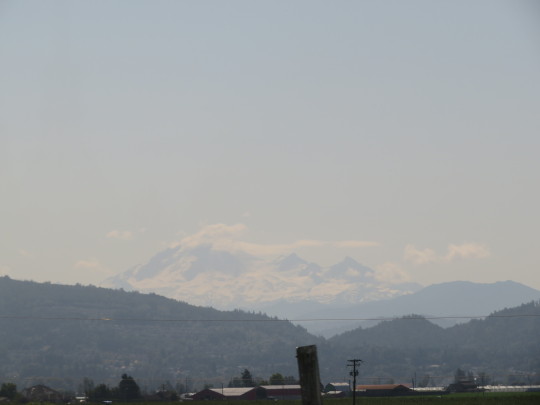
At this point I feel the need to point out 2 important things: 1. I took over 200 photos today 2. All photos were taken through the windows of the train, and are therefore subject to reflections off the glass - watch out for the little UFOs, they are reflections of the lights in the carriage ceiling!
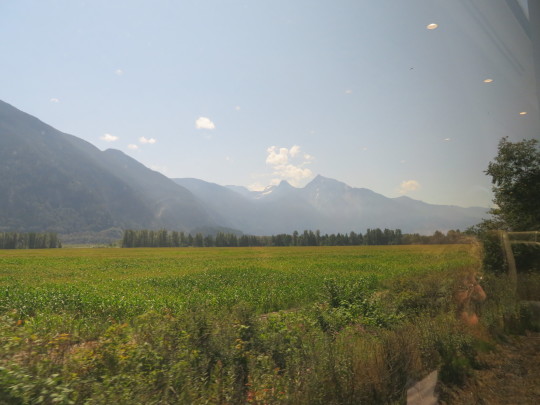


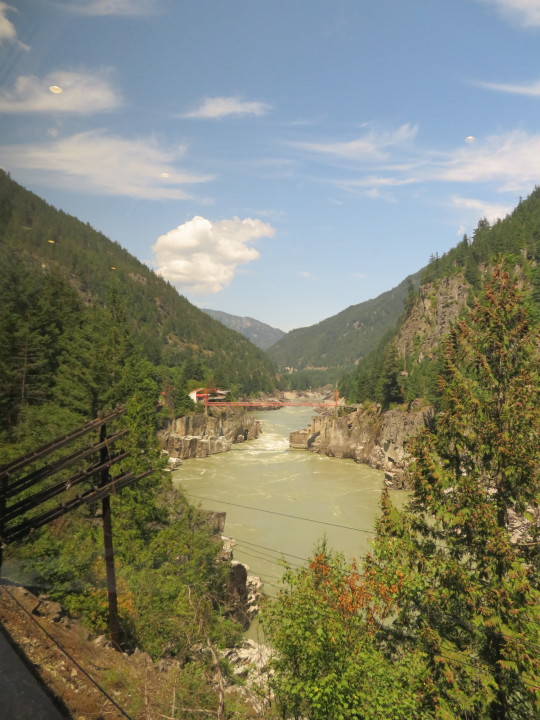

I also should point out seeing mountains like these is kinda exciting for me - Australia's mountains aren't like this! And the train follows the Fraser River pretty closely. The grey-green colour of the water is apparently due to the sediments it carries - they never get a chance to settle.
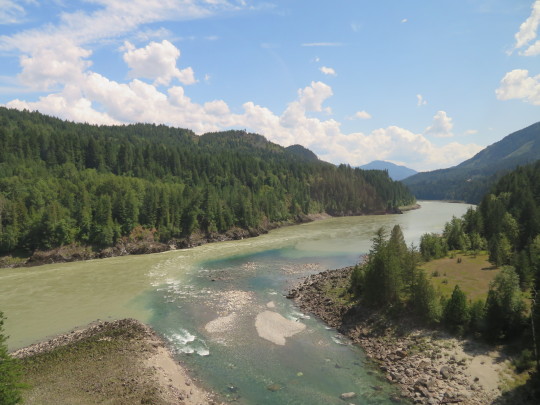
Speaking of colours . . . this mixture of blues and greens is because it's part of where the Fraser meets the Thomson River, which the train then follows to our eventual overnight stop in Kamloops.
This train trip is like being in a moving restaurant - we were supplied with drinks and a snack, then a 3 course lunch by the time we hit this point!

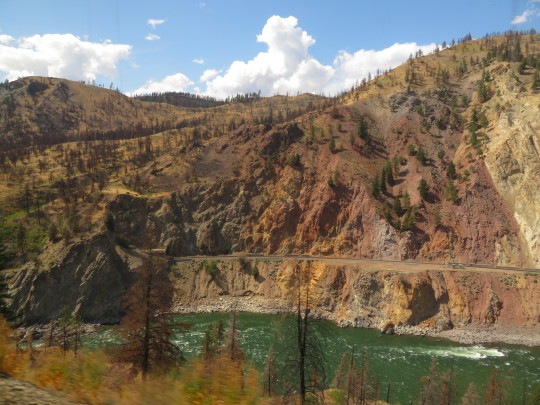
Rainbow Canyon - the colours of the rocks caused by oxidation of iron, copper and sulfur (I think that's what they said!)
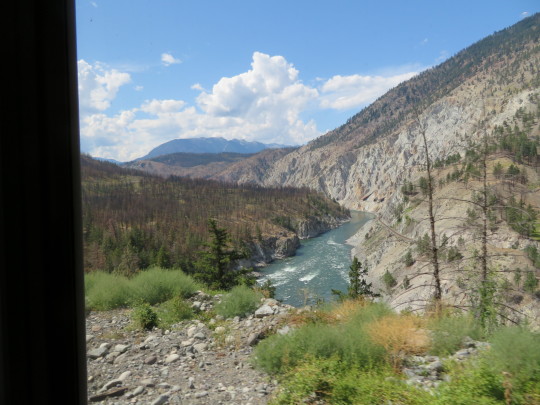

I was really on the wrong side of the train to get shots of the rapids on the Thompson, where some of the rocks have names! Can you spot the rock called the frog? (right pic above)



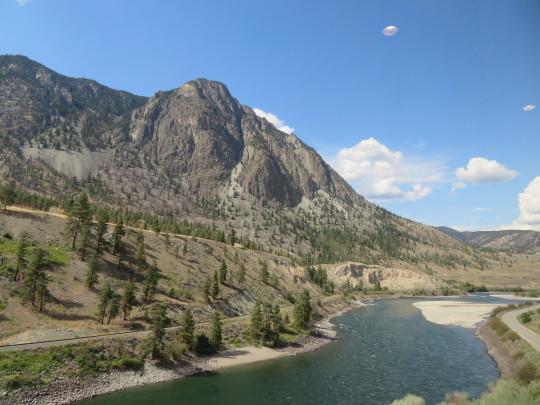
Murray Creek Falls . . .
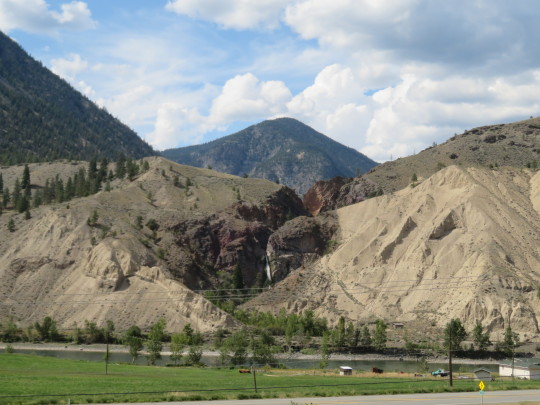
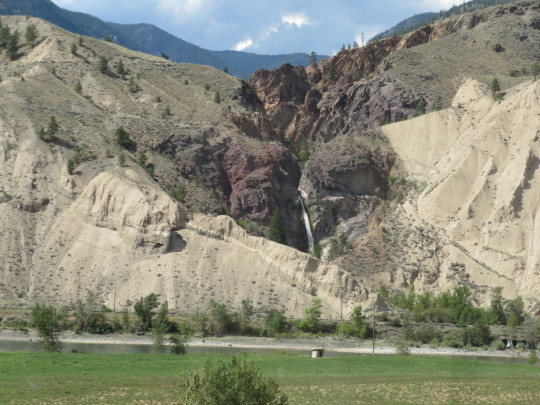
On one of our many stops while waiting on a siding for a freight train to pass in the opposite direction, we had a Bald Eagle circling beside us. Not easy to snap pics!

Somewhere near Black Canyon we had one of the best chances to shoot pics of the front of the train - my carriage was the second last of 22 "pieces of equipment" (engine, carriages inc non-passenger cars), and the last passenger car. (I still had trouble getting a decent shot without reflections or telephone wires in the way!)
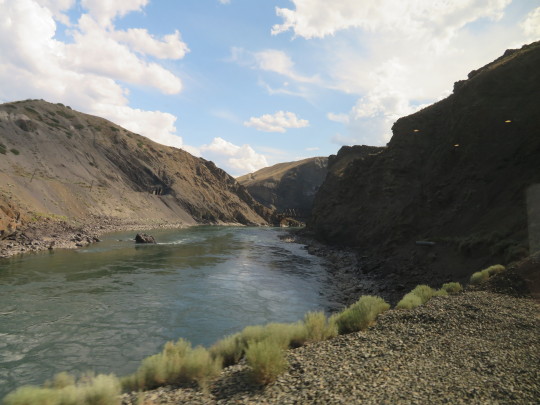

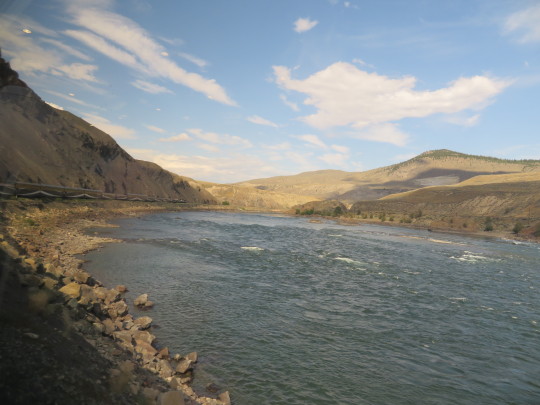

We spent much of the day spotting Osprey nests! (And one or two eagle nests)
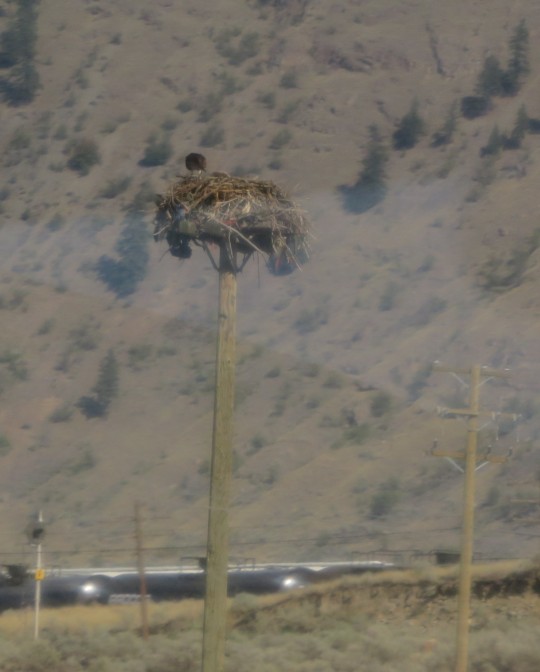
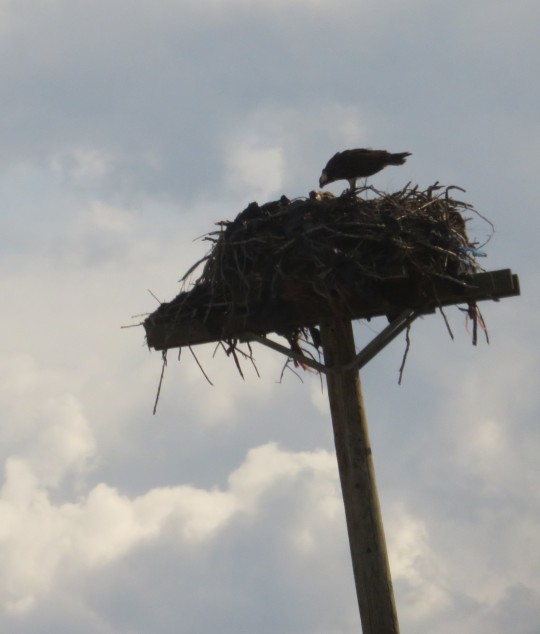
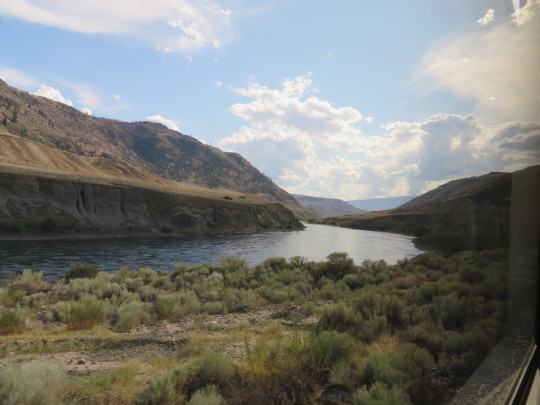
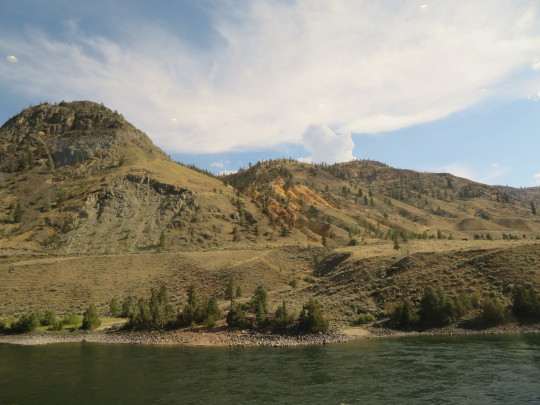
Does anyone recognise Rainbow Bluffs? Apparently they appeared in the X-Files. (right pic above)
After many, many delays pulling into sidings for freight trains (the two I counted cars for were 150 and 194 cars long - so not short trains!), and our afternoon snack and drink, we finally came up along Kamloops Lake. Lots of winding track as the train closely follows the shoreline.
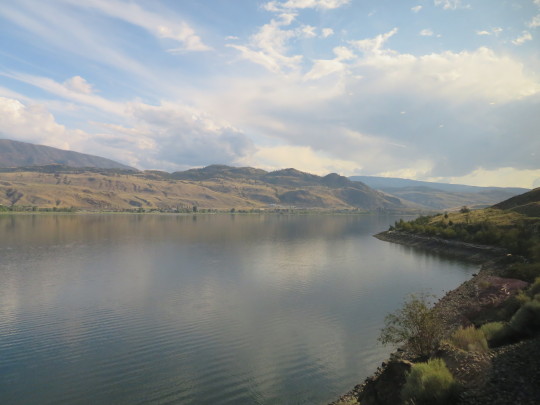
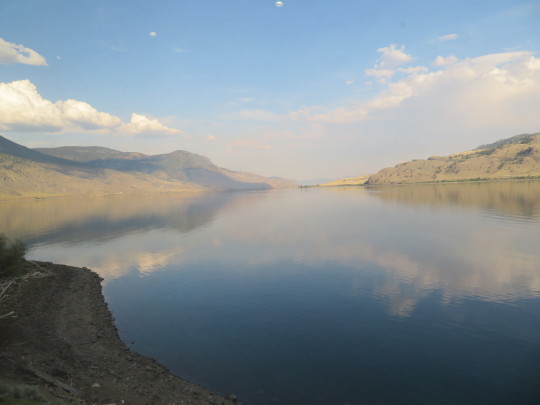
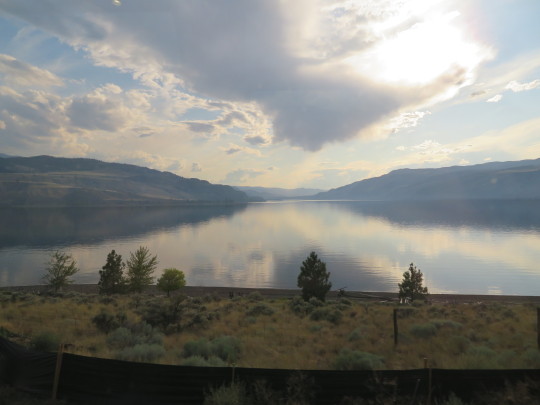
And that's my 30 image limit!
We were late getting into Kamloops - so many stops along the way we even got a second afternoon snack!! So, when we finally reached our hotels it was around 9pm. That's basically a 13hr train trip! Certainly not boring though.
#my big north america adventure#day 11#rocky mountaineer#vancouver to kamloops#british columbia#long day on a train
14 notes
·
View notes